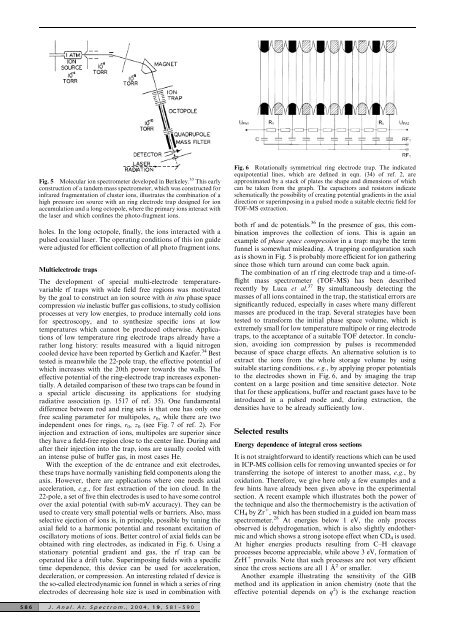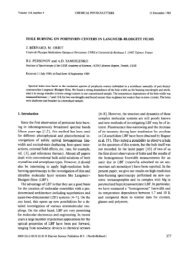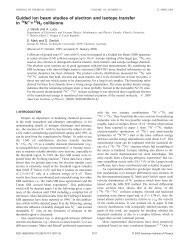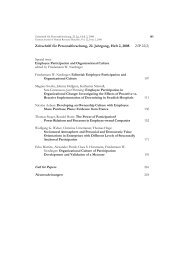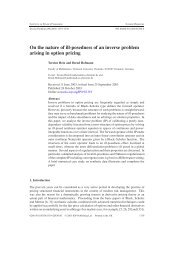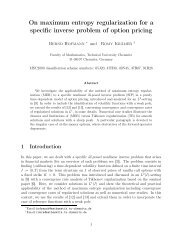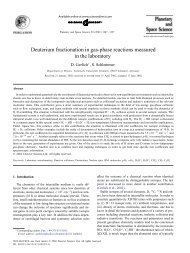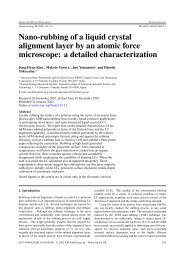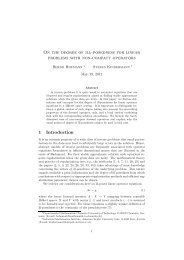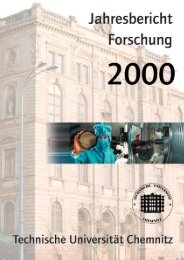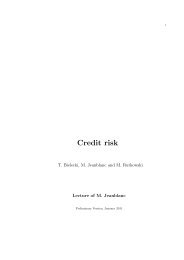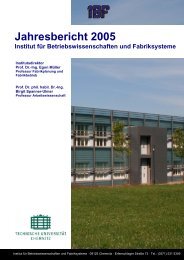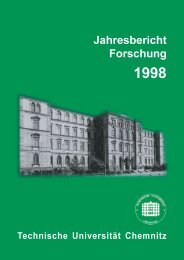Applications of rf fields and collision dynamics in atomic mass ...
Applications of rf fields and collision dynamics in atomic mass ...
Applications of rf fields and collision dynamics in atomic mass ...
Create successful ePaper yourself
Turn your PDF publications into a flip-book with our unique Google optimized e-Paper software.
Fig. 5 Molecular ion spectrometer developed <strong>in</strong> Berkeley. 33 This early<br />
construction <strong>of</strong> a t<strong>and</strong>em <strong>mass</strong> spectrometer, which was constructed for<br />
<strong>in</strong>frared fragmentation <strong>of</strong> cluster ions, illustrates the comb<strong>in</strong>ation <strong>of</strong> a<br />
high pressure ion source with an r<strong>in</strong>g electrode trap designed for ion<br />
accumulation <strong>and</strong> a long octopole, where the primary ions <strong>in</strong>teract with<br />
the laser <strong>and</strong> which conf<strong>in</strong>es the photo-fragment ions.<br />
holes. In the long octopole, f<strong>in</strong>ally, the ions <strong>in</strong>teracted with a<br />
pulsed coaxial laser. The operat<strong>in</strong>g conditions <strong>of</strong> this ion guide<br />
were adjusted for efficient collection <strong>of</strong> all photo fragment ions.<br />
Multielectrode traps<br />
The development <strong>of</strong> special multi-electrode temperaturevariable<br />
<strong>rf</strong> traps with wide field free regions was motivated<br />
by the goal to construct an ion source with <strong>in</strong> situ phase space<br />
compression via <strong>in</strong>elastic buffer gas <strong>collision</strong>s, to study <strong>collision</strong><br />
processes at very low energies, to produce <strong>in</strong>ternally cold ions<br />
for spectroscopy, <strong>and</strong> to synthesize specific ions at low<br />
temperatures which cannot be produced otherwise. <strong>Applications</strong><br />
<strong>of</strong> low temperature r<strong>in</strong>g electrode traps already have a<br />
rather long history: results measured with a liquid nitrogen<br />
cooled device have been reported by Gerlich <strong>and</strong> Kaefer. 34 Best<br />
tested is meanwhile the 22-pole trap, the effective potential <strong>of</strong><br />
which <strong>in</strong>creases with the 20th power towards the walls. The<br />
effective potential <strong>of</strong> the r<strong>in</strong>g-electrode trap <strong>in</strong>creases exponentially.<br />
A detailed comparison <strong>of</strong> these two traps can be found <strong>in</strong><br />
a special article discuss<strong>in</strong>g its applications for study<strong>in</strong>g<br />
radiative association (p. 1517 <strong>of</strong> ref. 35). One fundamental<br />
difference between rod <strong>and</strong> r<strong>in</strong>g sets is that one has only one<br />
free scal<strong>in</strong>g parameter for multipoles, r0, while there are two<br />
<strong>in</strong>dependent ones for r<strong>in</strong>gs, r0, z0 (see Fig. 7 <strong>of</strong> ref. 2). For<br />
<strong>in</strong>jection <strong>and</strong> extraction <strong>of</strong> ions, multipoles are superior s<strong>in</strong>ce<br />
they have a field-free region close to the center l<strong>in</strong>e. Dur<strong>in</strong>g <strong>and</strong><br />
after their <strong>in</strong>jection <strong>in</strong>to the trap, ions are usually cooled with<br />
an <strong>in</strong>tense pulse <strong>of</strong> buffer gas, <strong>in</strong> most cases He.<br />
With the exception <strong>of</strong> the dc entrance <strong>and</strong> exit electrodes,<br />
these traps have normally vanish<strong>in</strong>g field components along the<br />
axis. However, there are applications where one needs axial<br />
acceleration, e.g., for fast extraction <strong>of</strong> the ion cloud. In the<br />
22-pole, a set <strong>of</strong> five th<strong>in</strong> electrodes is used to have some control<br />
over the axial potential (with sub-mV accuracy). They can be<br />
used to create very small potential wells or barriers. Also, <strong>mass</strong><br />
selective ejection <strong>of</strong> ions is, <strong>in</strong> pr<strong>in</strong>ciple, possible by tun<strong>in</strong>g the<br />
axial field to a harmonic potential <strong>and</strong> resonant excitation <strong>of</strong><br />
oscillatory motions <strong>of</strong> ions. Better control <strong>of</strong> axial <strong>fields</strong> can be<br />
obta<strong>in</strong>ed with r<strong>in</strong>g electrodes, as <strong>in</strong>dicated <strong>in</strong> Fig. 6. Us<strong>in</strong>g a<br />
stationary potential gradient <strong>and</strong> gas, the <strong>rf</strong> trap can be<br />
operated like a drift tube. Superimpos<strong>in</strong>g <strong>fields</strong> with a specific<br />
time dependence, this device can be used for acceleration,<br />
deceleration, or compression. An <strong>in</strong>terest<strong>in</strong>g related <strong>rf</strong> device is<br />
the so-called electrodynamic ion funnel <strong>in</strong> which a series <strong>of</strong> r<strong>in</strong>g<br />
electrodes <strong>of</strong> decreas<strong>in</strong>g hole size is used <strong>in</strong> comb<strong>in</strong>ation with<br />
586 J. Anal. At. Spectrom., 2004, 19, 581–590<br />
Fig. 6 Rotationally symmetrical r<strong>in</strong>g electrode trap. The <strong>in</strong>dicated<br />
equipotential l<strong>in</strong>es, which are def<strong>in</strong>ed <strong>in</strong> eqn. (34) <strong>of</strong> ref. 2, are<br />
approximated by a stack <strong>of</strong> plates the shape <strong>and</strong> dimensions <strong>of</strong> which<br />
can be taken from the graph. The capacitors <strong>and</strong> resistors <strong>in</strong>dicate<br />
schematically the possibility <strong>of</strong> creat<strong>in</strong>g potential gradients <strong>in</strong> the axial<br />
direction or superimpos<strong>in</strong>g <strong>in</strong> a pulsed mode a suitable electric field for<br />
TOF-MS extraction.<br />
both <strong>rf</strong> <strong>and</strong> dc potentials. 36 In the presence <strong>of</strong> gas, this comb<strong>in</strong>ation<br />
improves the collection <strong>of</strong> ions. This is aga<strong>in</strong> an<br />
example <strong>of</strong> phase space compression <strong>in</strong> a trap: maybe the term<br />
funnel is somewhat mislead<strong>in</strong>g. A trapp<strong>in</strong>g configuration such<br />
as is shown <strong>in</strong> Fig. 5 is probably more efficient for ion gather<strong>in</strong>g<br />
s<strong>in</strong>ce those which turn around can come back aga<strong>in</strong>.<br />
The comb<strong>in</strong>ation <strong>of</strong> an <strong>rf</strong> r<strong>in</strong>g electrode trap <strong>and</strong> a time-<strong>of</strong>flight<br />
<strong>mass</strong> spectrometer (TOF-MS) has been described<br />
recently by Luca et al. 37 By simultaneously detect<strong>in</strong>g the<br />
<strong>mass</strong>es <strong>of</strong> all ions conta<strong>in</strong>ed <strong>in</strong> the trap, the statistical errors are<br />
significantly reduced, especially <strong>in</strong> cases where many different<br />
<strong>mass</strong>es are produced <strong>in</strong> the trap. Several strategies have been<br />
tested to transform the <strong>in</strong>itial phase space volume, which is<br />
extremely small for low temperature multipole or r<strong>in</strong>g electrode<br />
traps, to the acceptance <strong>of</strong> a suitable TOF detector. In conclusion,<br />
avoid<strong>in</strong>g ion compression by pulses is recommended<br />
because <strong>of</strong> space charge effects. An alternative solution is to<br />
extract the ions from the whole storage volume by us<strong>in</strong>g<br />
suitable start<strong>in</strong>g conditions, e.g., by apply<strong>in</strong>g proper potentials<br />
to the electrodes shown <strong>in</strong> Fig. 6, <strong>and</strong> by imag<strong>in</strong>g the trap<br />
content on a large position <strong>and</strong> time sensitive detector. Note<br />
that for these applications, buffer <strong>and</strong> reactant gases have to be<br />
<strong>in</strong>troduced <strong>in</strong> a pulsed mode <strong>and</strong>, dur<strong>in</strong>g extraction, the<br />
densities have to be already sufficiently low.<br />
Selected results<br />
Energy dependence <strong>of</strong> <strong>in</strong>tegral cross sections<br />
It is not straightforward to identify reactions which can be used<br />
<strong>in</strong> ICP-MS <strong>collision</strong> cells for remov<strong>in</strong>g unwanted species or for<br />
transferr<strong>in</strong>g the isotope <strong>of</strong> <strong>in</strong>terest to another <strong>mass</strong>, e.g., by<br />
oxidation. Therefore, we give here only a few examples <strong>and</strong> a<br />
few h<strong>in</strong>ts have already been given above <strong>in</strong> the experimental<br />
section. A recent example which illustrates both the power <strong>of</strong><br />
the technique <strong>and</strong> also the thermochemistry is the activation <strong>of</strong><br />
CH4 by Zr 1 , which has been studied <strong>in</strong> a guided ion beam <strong>mass</strong><br />
spectrometer. 28 At energies below 1 eV, the only process<br />
observed is dehydrogenation, which is also slightly endothermic<br />
<strong>and</strong> which shows a strong isotope effect when CD 4 is used.<br />
At higher energies products result<strong>in</strong>g from C–H cleavage<br />
processes become appreciable, while above 3 eV, formation <strong>of</strong><br />
ZrH 1 prevails. Note that such processes are not very efficient<br />
s<strong>in</strong>ce the cross sections are all 1 A˚ 2 or smaller.<br />
Another example illustrat<strong>in</strong>g the sensitivity <strong>of</strong> the GIB<br />
method <strong>and</strong> its application <strong>in</strong> anion chemistry (note that the<br />
effective potential depends on q 2 ) is the exchange reaction


